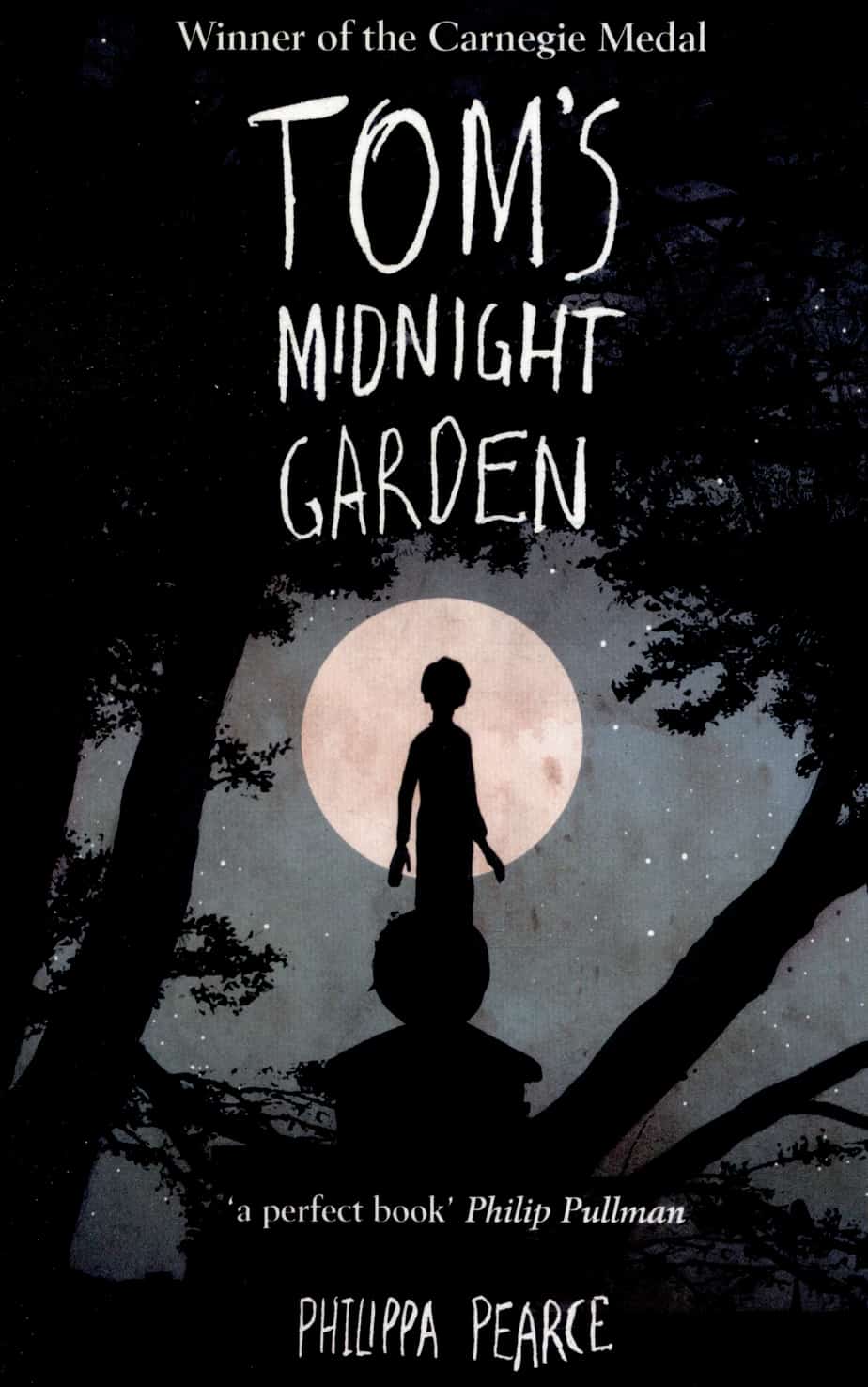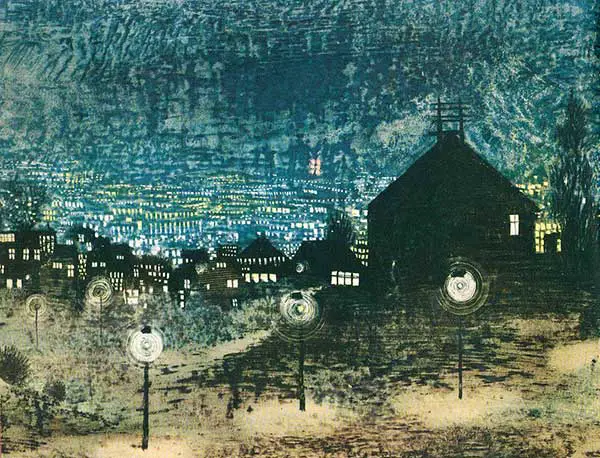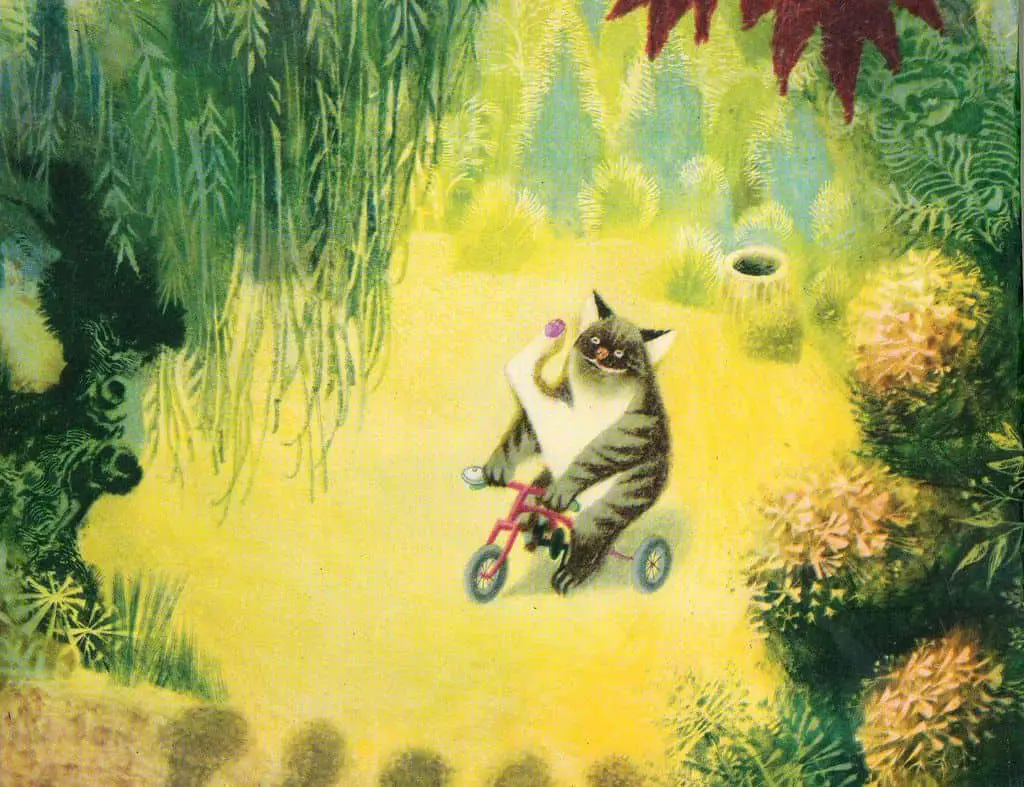A descendent of The Secret Garden, sibling of The Chronicles of Narnia and ancestor to The BFG, Tom’s Midnight Garden is an influential and much-loved book which won the Carnegie Medal.
In Tom’s Midnight Garden by Philippa Pearce the moon is heavily symbolic. Night = day as the fantasy world = the real world. This middle grade novel is an example of low fantasy.
SETTING OF TOM’S MIDNIGHT GARDEN
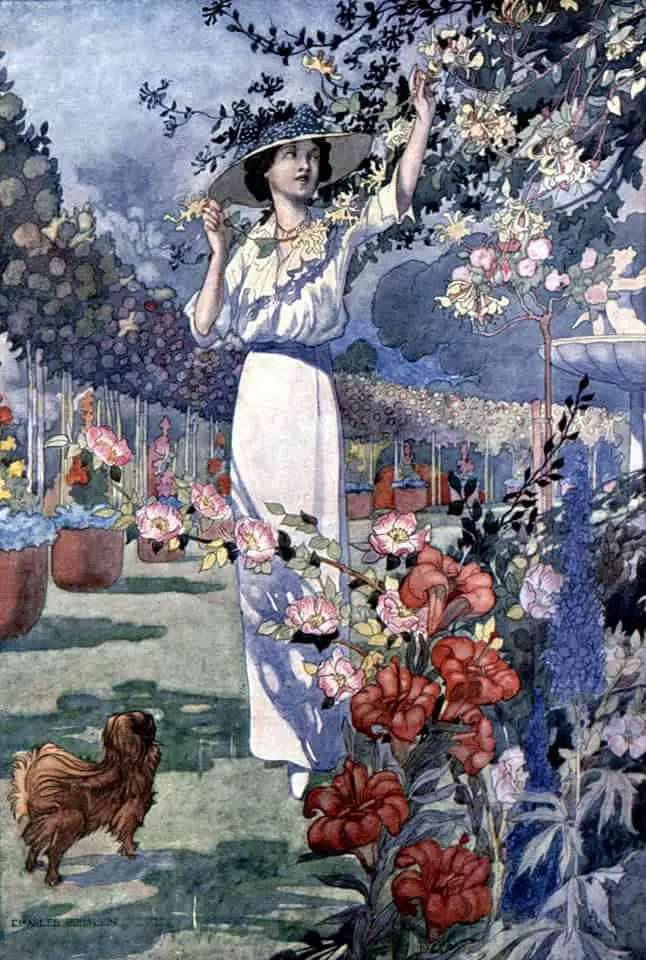
Real World Connection
The author grew up in Cambridgeshire but calls it Castleford here. This allows her to deviate from reality, placing objects where she likes them. It’s a convenient trick.
For the purpose of some of her fiction, including Tom, Pearce put a creative spin on the Cambridgeshire countryside. Thus, the villages of Great Shelford and Little Shelford became Great Barley and Little Barley. And the major city of Cambridge became Castleford minus the famous university. Oddly, the cathedral city of Ely, which figures prominently in Tom, retained its real name. And running throughout, the omnipresent River Cam became the River Say. Although not specifically mentioned in the book, all indications are that, since the real house and garden were located in Great Shelford, Pearce placed Tom and Hatty’s garden in, or very close to, the renamed Great Barley.
Fred Guida, SLJ blog
The story has been criticised for romanticising aristocratic England. We are lead to believe it’s a huge shame that the beautiful old mansion has been broken down into flats, but what is the alternative? For plebs to continue to live in servitude, while the aristocratic class live like kings?
The Mysterious Mansion
The aunt and uncle’s house is a large house surrounded by many little ones. We know immediately that this house is ‘different’. Mysterious. We can expect mysteries. It is also old — linked to the past — and was once a mansion but has since been divided into smaller flats. The aunt and uncle’s house lies north of Cambridgeshire, where the author herself grew up and where she set her stories.
Ghosts
Compared to Australians, at least, English readers are quite likely to believe in ghosts. It is therefore no surprise that Tom jumps to this conclusion after going through the portal.
Secondary World
This is a portal fantasy. The fantasy has similar workings to The Lion, The Witch And The Wardrobe in that a child stumbles upon a door to another world inside the house where they have been sent to escape something going on at home. When they go back to prove their discovery the world has disappeared — this world is meant only for Tom.
Measles
The story starts with a case of measles.
Measles have been a problem for humans for centuries. While white people developed some immunity over the centuries, they carried the measles virus to native people around the world and put severe, irreparable dents in their populations. In the 1950s, around 500,000 children a year caught the disease, and about 100 died as a result. It was therefore taken seriously. Tom’s Midnight Garden was published in 1958, and although breakthroughs were already being made at around this time it took another 10 years for children to start being vaccinated in Britain. However, people still weren’t vaccinating their children. As recently as 1988 there were still 80,000 cases of measles a year among children in England, including 16 deaths. This changed when the vaccination was combined into the MMR (measles, mumps, rubella) vaccine. The number of measles cases dropped significantly after that. But in 1998 there was another hit to the program after some false news emerged that vaccines cause autism. There has been some recovery from this scare, with around 95% of children receiving the vaccination, but there is still a large proportion of children of the 1990s who missed the vaccine and may never have it.
STORY STRUCTURE OF TOM’S MIDNIGHT GARDEN
SHORTCOMING
Tom Long is the main character.
His moral shortcoming is introduced first, though I may be having a different reaction to Tom as an adult reader who is now a mother — Tom doesn’t understand the reason for his being sent away and is in a strop about it. Instead of thinking about how much his brother must be suffering with measles he is completely inward-focussed and laments the loss of the summer he imagined, having fun with his brother climbing the apple tree in the backyard and so on. He fails to say a genuine farewell to his mother, though this is somewhat mutual.
The paragraph about the apple tree in the description of his own backyard tells us Tom’s need: He needs to be close to nature in order to be happy.
DESIRE
Tom’s desire is to stay in his own house and enjoy the freedom of typical summer holidays. Like many stories about children of this age, this is about one boy’s quest for freedom — spiritual if not actual.
OPPONENT
Tom’s mother is his first opponent, for wanting something different — she doesn’t want him to catch measles, and I’m sure she doesn’t want to have to look after more than one sick son at a time.
Uncle Alan and Aunt Gwen are opponents simply by virtue of conspiring with his mother to host him at their house.
Once at his aunt and uncle’s house a mysterious character is introduced, though adult readers will recognise The Woman In The Attic trope — “Mrs Barthlomew upstairs” who is the owner of the mysterious grandfather clock which strikes 13 o’clock. She dresses all in black and other adult characters give the impression she’s not to be messed with.
PLAN
Tom is fighting against his imprisonment. He plans to get around his measles quarantine in any way he can, even if it means never actually leaving the house. For starters he’ll find out the yard is like, even though it’s apparently nothing to write home about.
When he finds the magical garden he confronts his aunt and uncle, who lied to him about their poky little backyard. He realises only he can see it.
Now he needs to find out as much about it as he can.
The mystery deepens as characters emerge on the scene:
- Are they ghosts?
- Is Tom, perhaps, a ghost in the style of Sixth Sense or The Others? These Dead All Along films are much more recent than this children’s book of course, but they were based on older stories such as “An Occurrence At Owl Creek Bridge” from 1890 (also an episode of The Twilight Zone). I’m thinking maybe Tom died of the measles and though he thinks he was waving to his brother Peter he was actually waving to the live version of himself? The thing about the Dead All Along trope, once you realise the character is dead all along, everything prior in the story makes more sense. That’s not what happens in this case. The explanation is a bit different.
BIG STRUGGLE
The battle scene is Tom rushing downstairs trying to get through the gate and failing, realising he can never go back.
I’m sure this book is a Rorschach test, with the reader imposing individual meanings onto the text. For me this story is about the end of childhood. You can never go back. But what if you could? You can, of course, but only in your mind.
ANAGNORISIS
There is a ‘Scooby Doo’ chapter at the end in which all is explained. Mrs Bartholomew heard Tom screaming her name and summons him up to ‘apologise’, but really she wants to tell him that she is Hatty and Tom was sharing her memories.
NEW SITUATION
Tom has closure on the Midnight Garden and will return home satisfied. His uncle and auntie will remain a bit mystified about this slightly odd nephew of theirs.
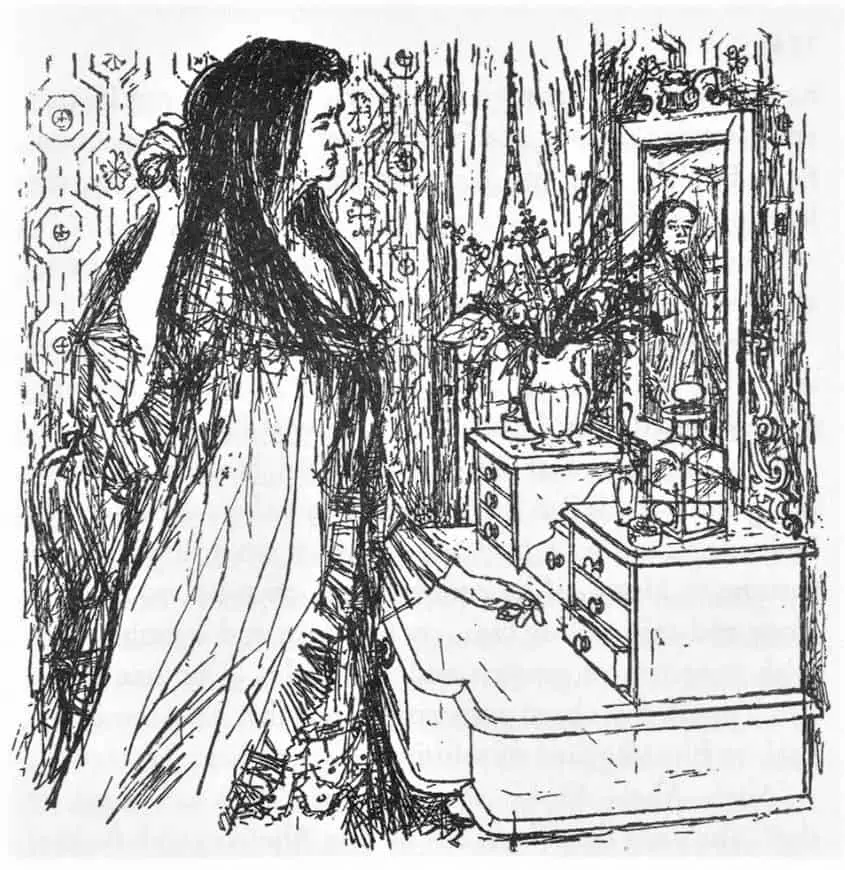
FURTHER NOTES
Food
Food is important in children’s literature. In utopian stories there is never any concern about where the next meal is coming from — it just appears. See for example The Wind In The Willows or Winnie The Pooh.
In this story, however, the abundant and delicious food is used to show how Tom is stifled. He lies in a ‘snail under the leaf setting’ — safe from harm in the suburbs with people who care for him and his every need met — but for a boy who needs to spread his wings this is a prison.
Aunt Gwen’s cooking was the cause of Tom’s sleeplessness — that and lack of exercise. Tom had to stay indoors and do crossword puzzles and jigsaw puzzles, and never even answered the door when the milkman came, in case he gave the poor man measles. The only exercise he took was in the kitchen when he was helping his aunt to cook those large, rich meals — large and richer than Tom had ever known before.
The Technique of Side Shadowing
For a breakdown of the 3 main types of literary shadowing see here.
Side shadowing lets the reader know how else the story might have panned out. One reason for using this is to offer alternative endings, to ask the reader to consider some sort of theme, like justice, or if the character made the right choice in the end.
But in the case of Tom’s Midnight Garden, Philippa Pearce uses side shadowing mainly to reassure us that ‘This is not just your run-of-the-mill ghost story. I know you think you know how this is going to pan out because you’ve read plenty of ghost stories, no doubt. But I’m telling you you’re in for a surprise!”
She achieves that message with the following passage, written using ‘would’. Notice too the metafictive reference to “Tom’s” reading lots of children’s books — when Tom is a stand-in for the child reader:
Tom resolved that, as soon as he was better, he would call on Mrs Bartholomew. True, she was an unsociable old woman of whom people were afraid, but Tom could not let that stand in his way. He would boldly ring her front door bell; she would open her front door just a crack and peer crossly out at him. Then she would see him, and at the sight of his face her heart would melt (Tom had read of such occurrences in the more old-fashioned children’s books; he had never before thought them very probable, but now it suited him to believe): Mrs Bartholomew, who did not like children, would love Tom as soon as she saw his face. She would draw him inside at once, then and there; and later, over a tea-table laden with delicacies for him alone, she would tell Tom the stories of long ago. Sometimes Tom would ask questions, and she would answer them. ‘A little girl called Harriet, or Hatty?’ she would say, musingly. ‘Why, yes, my late husband told me once of such a child — oh! long ago! An only child she was, and an orphan. When her parents died her aunt took her into this house to live. Her aunt was a disagreeable woman…’
So the story, in Tom’s imagination, rolled on. It became confused and halting where Tom himself did not already know the facts; but after all, he would only have to wait to pay his call upon Mrs Bartholomew, to hear it all from her own lips. She would perhaps end her story, he thought, with a dropped of her voice: [old fashioned melodrama based on the oral tradition] ‘And since then, Tom, they say that she and her garden and all the rest haunt this house. They say that those who are lucky may go down, about when the clock strikes for midnight, and open what was once the garden door and see the ghost of that garden and of the little girl.’
Tom’s mind ran on the subject. His cold was getting so much better […]
For me the side shadowing happens at exactly the right moment, as my attention is starting to flag and I’m wondering if I can already predict the ending of this story.
Pearce also makes use of foreshadowing and also backshadowing in this story — an example of backshadowing is the reference to Hatty’s sons dying in The Great War, which she explains is now known as the First World War. This sort of real world detail is knowledge shared between audience and characters.
